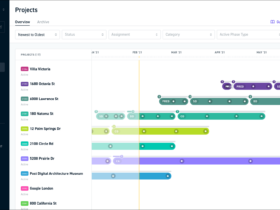The Team Software Process (TSP) is a defined operational process that provides guidance to engineers and managers in organizing projects and establishing an effective team-working environment. TSP includes team-building and team-working components that assist in defining roles for each team member, establishing teamwork, and dealing with engineering processes.
TSP was developed by the Software Engineering Institute (SEI) at Carnegie Mellon University in 2000 as a way to guide engineers and managers in using effective teamwork methods. It is designed to work in tandem with the Personal Software Process (PSP), which provides a structured approach for individual software engineers to improve their performance.
Together, TSP and PSP provide a framework for enhancing software development processes, promoting teamwork, and improving project outcomes.

Credit: itechnolabs.ca
Introduction To Team Software Process
Team Software Process (TSP) is a structured process framework that guides teams of engineers and managers through each step of the project development lifecycle. TSP is designed to help teams improve their performance and reduce the number of defects in software products. It is a part of the Personal Software Process (PSP) and is introduced to facilitate team development and team-building activities. TSP helps team members to establish clear roles, responsibilities, and communication channels to help them work together more effectively.
What Is Tsp And Its Objective?
Team Software Process (TSP) is a framework that guides teams of engineers and managers through each step of the project development lifecycle. Its objective is to help teams of engineers and managers work as an effective team and ensure software quality control during software development.
Brief History Of Tsp
The Team Software Process was developed at the Software Engineering Institute at Carnegie-Mellon University by Watts S. Humphrey. TSP began as an extension of the earlier Personal Software Process (PSP), which was designed to help individual programmers improve their performance and reduce errors in coding. TSP was introduced as a way to take the principles of PSP and apply them to larger teams of programmers working on complex projects.
Importance Of Tsp In Team Performance
The main importance of TSP lies in its ability to provide guidance and structure to help teams work together effectively. TSP helps team members to establish clear roles, responsibilities, and communication channels, as well as to set up a process for measuring and improving performance. Through TSP, teams can identify and address issues early in the development process, leading to better software quality, reduced costs, and more satisfied customers.
Tsp Methodology
The Team Software Process (TSP) provides a structured process framework for engineers and managers to organize and guide projects. It consists of two main components – team-building and team-working – that define roles and establish a teamwork environment, while also outlining engineering processes and practices for the team.
Team Software Process (TSP) is a methodology developed by the Software Engineering Institute (SEI) at Carnegie Mellon University. This methodology is designed to help software development teams improve efficiency and productivity. TSP combines the Personal Software Process (PSP) with team-building and team-working processes to create a structured framework for managing projects. In this blog post, we will focus on the TSP methodology and the principles, steps, and differences between PSP and TSP.Principles Behind Tsp
TSP is based on some fundamental principles that guide software teams in their work. These principles are:- Continuous Improvement – Teams must continuously strive to improve their work processes and practices.
- Defined Process – A defined process is necessary to guide teams in their work and improve productivity.
- Measurement-based Management – Accurate and timely measurement is essential to identify issues and improve the overall performance of the team.
- Quality focus – Quality must be the primary focus throughout the entire software development life cycle.
Steps Involved In Tsp
TSP involves several steps that software teams must follow to achieve its objectives. These steps include:- Preparation – During this phase, the team defines roles and responsibilities, establishes team norms and standards, and creates a project plan.
- Launch – In this phase, the team begins developing the software according to the project plan.
- Execution – During this phase, the team uses measurement and analysis to identify and correct issues in the software development process.
- Wrap-up – In the final phase, the team evaluates the project and creates a report on the lessons learned.
Difference Between Psp And Tsp
While the Personal Software Process (PSP) and Team Software Process (TSP) are similar, there are some notable differences between the two. PSP focuses on individual software development, while TSP involves a team approach. TSP combines the principles of PSP with team-building and team-working processes to achieve its objectives. Additionally, PSP is more formal and structured than TSP, which is less formal and structured. In conclusion, TSP provides a well-defined operational process to guide software teams through the team-building and team-working steps. By focusing on continuous improvement, measurement-based management, quality, and a defined process, software teams can improve their productivity, efficiency, and overall performance.The Team-building Phase
Team Software Process (TSP) is an operational process designed to guide engineers and managers through team-building steps, including defining roles and establishing effective teamwork. Without specific guidance, engineers must work out the details themselves. TSP, in short, provides a way for teams of managers and engineers to organize projects effectively.
Defining Roles For Each Team Member
Establishing clear roles for each team member is an essential part of building an effective team. The Team Software Process (TSP) methodology specifies this step as a key part of the team-building process. The TSP methodology provides specific guidance to help managers and engineers identify the different roles required for the team’s success. By defining roles, the team members can better understand their individual responsibilities and work collaboratively towards achieving common objectives.Team Launch And Periodical Relaunch
TSP launch and periodic relaunch are essential elements of the team-building process. TSP launch is a formal process that marks the beginning of the project, where the team gathers to set objectives, define goals and establish communication channels. The periodic relaunch is a recurring process that helps the team members to assess their progress, make adjustments to their plans and address any issues that arise. By regularly relaunching the team, they ensure that the project stays on track and that the team remains motivated and engaged.Establishing A Team-working Environment
Creating a supportive team-working environment is critical to the success of any project. The TSP methodology provides specific guidance on how to establish a team-working environment that encourages collaboration, communication and a positive team culture. The team leader must ensure that every team member knows their role and responsibilities, establish clear lines of communication, and provide regular feedback to the team. Additionally, it is essential to create an environment that promotes learning and continuous improvement, where team members can share their ideas and insights and learn from each other’s successes and failures. In conclusion, the Team Software Process (TSP) approach is an effective methodology to build and manage teams effectively. By defining roles, launching the team, and establishing a positive team-working environment, the TSP methodology provides specific guidance to help team members achieve common objectives collaboratively. TSP aims to foster a productive and engaging team working culture for the successful completion of the project.The Team-working Phase
The Team Software Process (TSP) provides a defined operational process framework to help engineers and managers establish an effective team-working environment. It specifies the steps needed to guide teams through the team-building phase and ensures that engineering processes and practices are utilized effectively to achieve successful project outcomes.
When it comes to software development, working in teams can be challenging. That’s where the Team Software Process (TSP) comes in. TSP is a methodology that helps guide engineers and managers through the process of team-building and team-working. The TSP provides a defined operational process to establish an effective team-working environment, which ensures that everyone is working towards the same goal.Engineering Processes And Practices Utilized By The Team
The TSP ensures that a uniform set of engineering processes and practices are utilized by the team to ensure that everyone is working towards the same goal. This makes it easier to track progress, identify issues, and continuously improve software development. Some of the engineering processes and practices that the TSP utilizes include requirements development, design, testing, and coding. By utilizing these best practices, the team can ensure that they are developing quality software that meets the needs of the end-users.Planning, Estimating, Tracking, And Improving Software Development
One of the key benefits of the TSP is that it provides a framework for planning, estimating, tracking, and improving software development. This ensures that the team is working efficiently and effectively towards the desired outcomes. Some of the key activities that the TSP includes in this phase are project planning, process planning, and progress tracking. By continuously tracking progress and making improvements, the team can ensure that they are delivering high-quality software that meets the expectations of their stakeholders.Tsp Tools And Techniques
The TSP utilizes a variety of tools and techniques to support the team-working and software development process. These tools and techniques are designed to help the team work more efficiently and effectively, and to identify and address issues as they arise. Some of the key TSP tools and techniques include peer reviews, data collection, and analysis, and the use of metrics. By utilizing these tools and techniques, the team can ensure that they are working towards a common goal, and that they are continuously improving their processes and practices.Benefits Of Tsp
Team Software Process (TSP) is a methodology that defines a framework to guide managers and engineers through the process of team-building and team-working. TSP works in combination with Personal Software Process (PSP) and provides specific guidance to establish an effective team-working environment. Here are some of the benefits of TSP:
Improving Software Quality
TSP methodology has a strong focus on software quality. It provides guidelines for engineering processes and practices that help in the development of high-quality software. By following the guidelines provided by TSP, teams can ensure that the software they develop meets the required standards of quality and reliability.
Increasing Predictability And Control
TSP methodology provides a defined operational process framework that helps teams of managers and engineers organize projects efficiently. The TSP approach emphasizes early planning and continuously monitoring progress, which increases predictability and control over the project. This enables teams to complete projects on time and within budget.
Promoting Collaborative Teamwork
TSP methodology places a strong emphasis on promoting collaborative teamwork. It provides specific guidance on team-building, which helps to establish an effective team-working environment. By encouraging collaboration and teamwork, TSP helps to improve communication and build trust among team members. This leads to better decision-making and problem-solving, which ultimately enhances the overall performance of the team.

Credit: www.matellio.com
Implementing Tsp
Team Software Process (TSP) is a process framework designed to assist teams of managers and engineers in organizing projects, in conjunction with Personal Software Process. The TSP specifies the steps needed to establish an effective team-working environment and provide guidance through team-building and team-working process.
an integral part of the Team Software Process (TSP), which is designed to provide engineers and managers with a defined operational process framework for organizing projects and teams. While the TSP specifies the steps needed to establish an effective team-working environment, implementing the process comes with its own challenges. In this section, we will explore the challenges that come with adopting TSP, the necessary training and mentoring required for successful implementation, and some TSP success stories.Challenges In Adopting Tsp
Adopting TSP requires significant changes in the way software development and project management are approached. Some of the most common challenges faced by organizations include resistance from the team members, lack of management buy-in, and the need for a significant investment of time and resources to implement the process successfully.Training And Mentoring Required For Successful Implementation
To overcome the challenges of adopting TSP, organizations need to invest in proper training and mentoring. This includes providing training to team members, coaches, and managers on TSP concepts and techniques. Additionally, teams need to work with experienced coaches to implement TSP effectively and get guidance on how to overcome challenges that may arise during the adoption process.Tsp Success Stories
Despite the challenges of implementing TSP, many organizations have successfully integrated TSP into their software development processes. For instance, a telecommunications company was able to increase productivity by 80% after implementing TSP. Another success story involves a software development team that was able to reduce errors by 90% and decrease the time required to complete a project by 40% after adopting TSP. In conclusion, implementing TSP requires a significant investment of time and resources, with various challenges to overcome. However, with proper training and mentoring, organizations can successfully integrate TSP into their software development processes and see significant improvements in productivity, project management, and error reduction.Tsp Best Practices
Team Software Process (TSP) is a methodology designed to guide engineers and managers in establishing an effective team-working environment. TSP provides a defined operational process framework that can be used by teams of managers and engineers to organize their projects and achieve better results.
It involves two principal components; team-building and team-working.
The Team Software Process (TSP) is an operational process framework that helps teams organize software development projects. The TSP includes two primary components: team-building and team-working. To ensure success, teams must implement TSP best practices. These include establishing clear objectives and milestones, emphasizing continuous improvement, and fostering open communication and feedback.Establishing Clear Objectives And Milestones
The first step in implementing TSP best practices is to establish clear objectives and milestones. This involves defining what the team hopes to accomplish and outlining the specific steps needed to achieve those goals. Clear objectives help team members stay focused on their priorities and prevent them from getting distracted by less important tasks. Milestones provide the team with a sense of progress and accomplishment. They also act as checkpoints, allowing the team to identify and address any issues that may arise.Emphasizing Continuous Improvement
Another essential TSP best practice is to emphasize continuous improvement. This involves taking a proactive approach to identifying opportunities for improvement and implementing changes as necessary. Teams that value continuous improvement are more likely to produce high-quality software, as they are constantly looking for ways to enhance their processes and methodologies. Continuous improvement also helps teams stay current with the latest developments in software development and technology.Fostering Open Communication And Feedback
Finally, successful teams implement TSP best practices by fostering open communication and feedback. Open communication helps team members share ideas, identify areas for improvement, and solicit feedback from one another. Feedback is essential for improving team performance and ensuring that everyone is working toward the same objectives. Teams that value open communication and feedback are better equipped to respond to changes in project requirements and to overcome obstacles that may arise. In conclusion, the TSP provides an effective operational process to guide teams through the software development process. To ensure success, teams must implement TSP best practices, which include establishing clear objectives and milestones, emphasizing continuous improvement, and fostering open communication and feedback. By following these guidelines, software development teams can produce high-quality software that meets the needs of their clients and end-users.
Credit: radixweb.com
Frequently Asked Questions For What Is Team Software Process
What Is The Team Software Process?
The Team Software Process (TSP) is a defined operational process that helps engineers and managers organize projects through team-building and team-working steps. It specifies the actions required to establish an effective team-working environment, providing engineers with specific guidance to avoid working out team-building details by themselves.
TSP is a software engineering methodology that assists teams of developers to work together efficiently.
What Is The Tsp Methodology?
The Team Software Process (TSP) is a project management methodology designed to guide managers and engineers in establishing an effective team-working environment. It provides a defined operational process framework, which includes team-building and team-working components that deal with engineering processes and practices utilized by the team.
TSP is often used in combination with the Personal Software Process (PSP) to manage software development projects in virtual and face-to-face environments.
What Is The Difference Between Psp And Tsp?
The Team Software Process (TSP) is a project management process designed for virtual environments. It includes team-building and team-working components, with less structure than the more formalized Project Software Process (PSP). TSP provides specific guidance for engineers and managers through team-building and teamworking steps, helping them to establish effective team working environments.
What Are The 4 Main Activities Of Software Process?
The four main activities of software process are specification, development, validation, and evolution. These activities may be organized differently in different software development processes. The Team Software Process (TSP) provides a framework to guide engineers and managers through these activities and establish an effective team-working environment.
TSP has two principal components: team-building and team-working.
Conclusion
As we come to the end of this article, we can conclude that the Team Software Process (TSP) is an effective framework designed to guide engineers and managers through the team-building steps. By defining roles for each team member and setting up teamwork through TSP launch and relaunch, it provides an operational process that incorporates effective team-working practices.
Adopting TSP can be highly beneficial for engineers working on complex software projects, as it empowers them to work together more efficiently and effectively. TSP can help teams achieve their goals by providing the guidance and structure they need to work cohesively and productively.











Leave a Reply